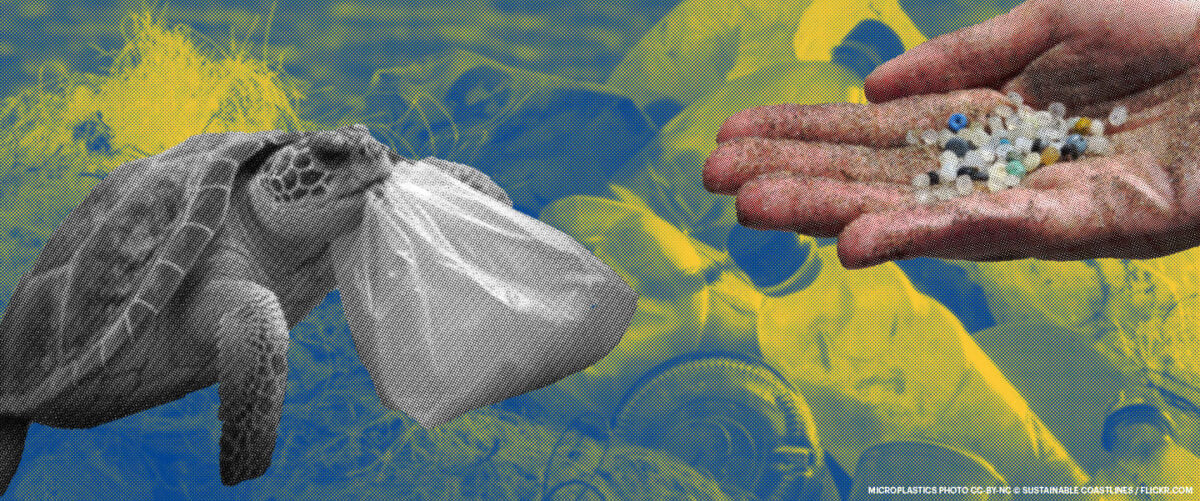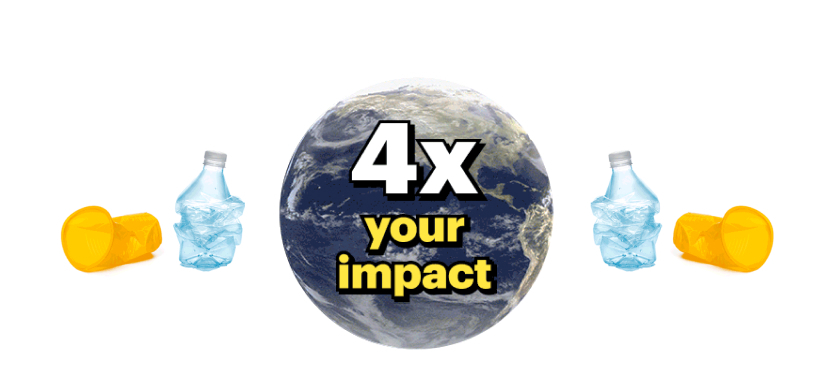The Top 3 Problems With Plastic in Our Oceans
Published May 11, 2023

Plastic in the oceans not only endangers wildlife, it also carries dangerous pollutants and worsens climate change.
Update (October 25, 2023): This week, Sen. Jeff Merkley (D-OR) and Rep. Jared Huffman (D-CA) reintroduced the Break Free From Plastic Pollution Act. This bill would be a massive first step to reducing plastic pollution and stopping the fossil fuel industry from locking us in to more oil, gas, and plastic production.
The Break Free From Plastic Pollution Act would ban many single-use, non-recyclable plastic products (like single-use carry-out bags) nationwide. It would also require makers of packaging, containers, and food service products to create waste management programs.
Help us build a safer, healthier, more sustainable future by calling on your representative to support the Break Free From Plastic Pollution Act!
When we think of our oceans, we may see crystal clear waters and pristine sandy shores. But more and more, that vision is becoming a fantasy. Plastic pollution is blighting our beaches and polluting our oceans, with no signs of stopping if Big Oil gets its way.
That’s because, amid calls for an energy transition, fossil fuel corporations are looking to plastics as a lifeline. The result: a huge plastics boom. The United Nations anticipates that annual plastic production will quadruple from 2020 to 2050, reaching 1.6 billion metric tons produced yearly.
Much of this plastic becomes single-use packaging that we throw away almost as soon as it reaches our hands. And millions of metric tons of plastic enter the environment annually, where it will remain for hundreds to thousands of years.
The consequences are disastrous for wildlife and ecosystems around the world, including those in our oceans. If current trends continue, these problems will only get worse. Here are the top three worst ways the plastic boom endangers our oceans.
1. Plastic Clogs the Ocean and Kills Wildlife
In the central Pacific Ocean, four major ocean currents have brought waste into a slow-moving “plastic soup.” Dubbed the Great Pacific Garbage Patch, the world’s largest dump is four times the size of California.
Every day, more discarded plastics join this rapidly growing, floating mass of trash, which is just one of five gigantic plastic trash heaps polluting the ocean.
Plastic pollution is a huge threat to biodiversity, impacting more than 600 marine species. Plastic debris frequently floats at the ocean’s surface, mixing with food sources, where it entangles wildlife.
Entanglement is a huge problem for animals, including seals, sea lions, turtles, and puffins. Plastic trash like bags can choke and suffocate them, or cut into their skin and create deadly infections.
Moreover, many animals mistake plastic for food and eat it. Large chunks of plastic have accumulated in whales’ stomachs, causing them to starve to death. Sea turtles, including critically endangered leatherbacks, accidentally consume plastic bags, mistaking them for the jellyfish they usually eat. Scientists have also found plastic pellets in endangered puffins’ stomachs.
Learn more about plastics’ threat to our oceans in our recent fact sheet, “How Plastic Pollution Endangers Ocean Ecosystems.”
2. The Toxins in Plastic Poison Our Oceans
In addition to large plastic waste, the oceans contain trillions of microplastic* particles. We can now find microplastics in open oceans, freshwater sources, lake sediments, riverbeds, and the deepest ocean trenches.
Plastics can contain any number of thousands of different additives, many of which are hazardous. These may leach out as the plastic ages, and can make up half of plastic by weight.
Some are extremely noxious, many have been linked to chemical toxicity, and some disrupt hormone functions in animals. Plastic waste can also carry and accumulate heavy metals, pathogens, and chemicals.
While large plastic waste has the most visible impacts on ocean life and seabirds, eating microplastics is also extremely harmful. Animals can absorb additives, such as nonylphenol and bisphenol, that leach from plastic.
As a result, microplastics can cause liver toxicity in fish, accumulate toxic chemicals in the fat tissue of sea birds, and impair cell function in mussels. Microplastic exposure also kills sea urchin embryos.
3. Plastic Disrupts Our Vital Carbon Cycle
Oceans are an essential part of our planet’s carbon cycle, which moves carbon between the Earth and the atmosphere. This is key to a well-functioning planet, as carbon is a crucial ingredient not only to life, but also to regulating Earth’s temperature.
To that end, the oceans are home to a lot of organisms, like algae and plankton, that pull carbon from the atmosphere through photosynthesis. In fact, ocean life is responsible for half of all earth’s photosynthesis.
Moreover, marine animals create a “biological pump” that removes more than 10 billion tons of carbon from the surface of the ocean each year. That includes 22 trillion pounds of plankton-eating fish, which feed at the surface during the day and bring the carbon to the ocean depths at night.
These fish account for more than 40% of carbon sequestration in some parts of the ocean. Unfortunately, they are now consuming large amounts of plastic, which could disrupt that sequestration.
Zooplankton also help sequester carbon, as their carbon-rich waste naturally sinks to the depths of the ocean. But zooplankton are eating microplastics, which replaces that waste.
By interfering with processes like these, plastic pollution contributes to climate change. And to make matters worse, microplastics in ice reduce the ice’s reflectiveness. That means the ice absorbs more heat and melts more (which raises sea levels), causing even more warming.
We Need to Cut Plastic Production to Save Our Oceans
Once made and tossed, plastic is a major threat to ocean life and ecosystems. But it’s dangerous at every step of the production process. From drilling fossil fuels (key ingredients for 90% of plastics), to burning the dirty fuels that power production, to the manufacturing process, plastic spews pollution into our air and water while wreaking havoc on our climate.
Ultimately, it doesn’t matter how many beach clean up days we have if we don’t tackle plastic pollution at its source — fossil fuels. To save our oceans and restore natural processes and ecosystems, we need to tackle dirty energy and fossil fuel corporations.
Help us fight Big Oil’s plastic-palooza. Tell your Congressmembers to support the Break Free From Plastic Pollution Act!

Time to face it —~it’s people or plastics.~We can’t have both.
Become a plastic pollution fighter this Earth~ Day and have your gift MATCHED $3-to-$1!
Enjoyed this article?
Sign up for updates.
TO TOP


